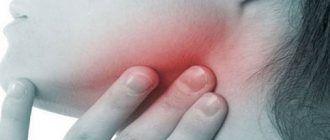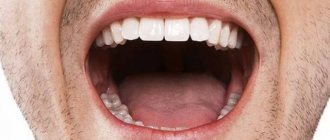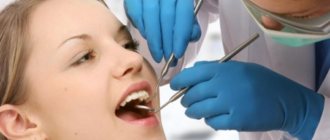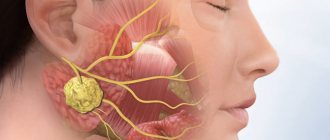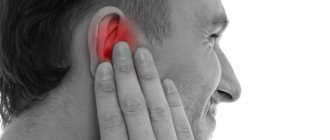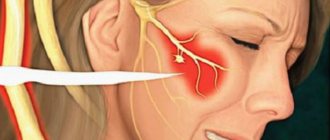Chronic sialadenitis is an inflammation of the salivary glands, in which periods of exacerbation alternate with periods of remission. This type of disease manifests itself differently in men, women and children. During reduced activity of the pathological process, symptoms of the inflammatory process are practically absent. During an exacerbation, there is a painful swelling in the cervical spine, an unpleasant taste in the mouth, and difficult salivation. Treatment is aimed at containing changes in the structure of the salivary gland tissue and eliminating painful symptoms.
Classification of forms of chronic sialadenitis
Depending on the area of localization and similarity of symptoms, three main forms of sialadenitis are distinguished:
- Parenchymal sialadenitis . Parenchyma is the collection of functional cells that make up the salivary gland. The inflammatory process is based on changes in cells of this type. Women are more often susceptible to this form of the disease. Parenchymal sialadenitis affects the parotid salivary glands.
- Interstitial sialadenitis. This type of inflammation occurs in the interlobular space of the gland. Most often it affects men. Interstitial sialadenitis affects the submandibular salivary glands.
- Ductal sialadenitis Occurs due to congenital pathology of the salivary ducts or as a result of their injury. Most often it occurs in older people.
What to do when saliva stops fulfilling its purpose
Inflammation of the salivary glands in medicine is called sialadenitis and has an ICD-10 code of K11.2. This disease is bacterial in nature and is very dangerous, because in the absence of adequate therapy, it can lead to clogging of the salivary ducts, the formation of stones in them, purulent lesions and destruction of surrounding tissues.
To know when it’s time to sound the alarm, read the material below - it will help you navigate and discern the first symptoms of danger, diagnose the pathology and treat it correctly.
Treatment of chronic sialadenitis
Treatment of chronic sialadenitis is aimed at preventing changes in gland tissue, normalizing saliva secretion and eliminating the inflammatory process.
During an exacerbation, the dentist prescribes a course of broad-spectrum antibiotics. In the absence of a bacterial infection, therapy may be limited to antiseptic rinses and the administration of a vitamin complex to support immunity. In complex therapy, it is possible to carry out physiotherapeutic procedures, such as electrophoresis or magnetic laser therapy. In rare cases, if conservative treatment is ineffective and the gland loses function, surgical intervention is possible.
A few words about the salivary glands
Everyone's oral cavity is lined with mucous membrane, and on its surface there are several pairs of salivary glands:
- parotid: they are located under the auricle and are the largest. They become inflamed more often than others, then sialadenitis of the parotid gland occurs,
- submandibular: located under the lower jaw and lower dentition. When they become inflamed, submandibular sialadenitis occurs,
- sublingual: they are located to the right and left of our tongue.
What do salivary glands do in our body? During normal functioning, they secrete secretions, or simply saliva, through special ducts located in the mouth. This clear, viscous liquid helps us soften pieces of food before entering the esophagus and stomach. Thanks to it, the process of swallowing and digestion goes smoothly. In addition, sublingual saliva produces protective enzymes that help fight pathogenic microflora in the mouth, destroy bacteria and wash away plaque. Thus, it protects teeth and gums from excessive accumulation of cariogenic bacteria, plaque and the development of stomatitis.
If bacteria somehow get into the salivary duct, it becomes infected and in 42-54% of all cases a person develops sialadenitis of the salivary gland. The disease can affect one type of gland, can spread symmetrically, or can involve absolutely all ducts located in the oral cavity. And if at the same time a person continues to ignore the alarming symptoms of the disease, then saliva simply ceases to be produced in the required quantity, as a result of which the quality of nutrition and digestion begins to suffer, and dental problems appear. But let's talk about everything in order.
How to prepare for the procedure
Ultrasound of the salivary glands is an absolutely safe and painless manipulation, for which the patient does not require special preparation. Patients of almost any age tolerate the procedure well, without showing any anxiety before and during its implementation, and therefore it does not require premedication (pre-administration of sedative medications) even in children.
On the eve of the visit to the specialist (about 3-4 hours in advance), the patient is advised to refrain from eating, and immediately before the examination he needs to thoroughly clean the oral cavity.
Why does the salivary gland become inflamed?
The main instigators of the disease are always bacteria and viruses that take advantage of weakened human immunity, poor oral hygiene, colds, bad habits and poor nutrition, stress, vitamin deficiencies, work overload, and begin to actively reproduce. Only they get into the salivary gland in different ways.
The most common route is through the oral cavity, where a large number of streptococci, staphylococci, colibacteria, and anaerobic flora are colonized. Less commonly, bacteria can enter through airborne transmission, through blood vessels and lymph. The risk of developing sialadenitis, i.e. inflammation of the parotid, submandibular or sublingual salivary glands especially increases in those who during this period are or have been ill with caries, sore throat, acute forms of ARVI and respiratory diseases, tracheitis, periodontitis, furunculosis, mumps (mumps) and even conjunctivitis. People suffering from malignant tumors, endocrinology, diabetes mellitus, HIV infection, dysbacteriosis, and anorexia are also at risk.
The disease can also develop if, for example, tissues that are located near the salivary gland are inflamed or have undergone surgery. A pathological process also appears when there is a blockage in the gland duct caused by the ingress of solid food debris or foreign objects, injury, salivary stone disease (then doctors call the pathology calculous sialadenitis).
Important! Inflammation of the sublingual, parotid or submandibular salivary gland can be provoked by viral microorganisms Coxsackie and Einstein-Barr, cetamegalovirus, herpes simplex, influenza viruses, Koch's bacillus, mycobacterium tuberculosis, treponema pallidum (occurs in the body against the background of syphilis).
Classifications and forms of the disease
We have discussed the causes of inflammation of the salivary glands. But due to the variety of factors leading to the disease, doctors distinguish different types of pathology. Naturally, based on the form of sialadenitis, treatment is subsequently prescribed. Therefore, for example, conducting therapy at home, without consulting a doctor, is pointless. After all, you cannot be sure what caused the disease.
| Characteristic | Classification |
| By etiology |
|
| According to the clinical picture |
|
| By mechanism of appearance |
|
| By area of localization |
|
| By type of localization within one salivary gland |
|
| With the flow |
|
Traditional medicine in the treatment of sialadenitis
Drugs from this category really help reduce symptoms, but do not stop the progression of the inflammatory process. Therefore, before using decoctions, you should consult a doctor and do not refuse drug treatment. The most effective in the treatment of sialadenitis are decoctions of:
- chamomile flowers and eucalyptus leaves;
- peppermint leaves and elderflower flowers;
- yarrow and viburnum leaves.
In any case, visiting a doctor is inevitable. You can make an appointment with a specialist on our website.
Symptoms of pathology
Acute sialadenitis leads to enlargement and hardening of the affected salivary gland. Naturally, the soft tissues around it swell and the skin turns red. What else does a sick person feel:
- from the body: a weak condition, a person may shiver, the body temperature may rise to 38-39 degrees, shortness of breath may appear,
- pain: they occur when palpating the inflamed area, when opening the mouth, when chewing and swallowing food, when turning the head. The pain is sharp, shooting, can radiate to the ear, head, neck, temples, frontal lobe,
- in rare cases, ear congestion occurs,
- taste sensations change or are disrupted: a person loses appetite,
- saliva may cease to be produced in the required quantities: the mouth feels dry. The separated saliva also contains an admixture of pus, heterogeneity, clots of mucus, and it becomes cloudy.
On a note! When a person’s parotid glands become inflamed and increase in size, ordinary people talk about mumps. This is easy to explain, because outwardly the patient’s neck swells and is very similar in structure to the neck of a well-known animal.
If a person ignores the manifestations of the disease and does not treat it, then he is not immune from chronic sialadenitis. Which occurs with periods of exacerbation, accompanied by minor pain, bad breath, dry mouth, and changes in taste perception.
“Despite the fact that inflammation of the salivary glands has characteristic symptoms, many patients do not look for the causes of its occurrence and do not strive to quickly receive qualified treatment. And all because pathology is very insidious. Short periods of deterioration are replaced by stabilization of the condition, a complete absence of symptoms, when the patient again feels completely healthy and attributes everything to temporary difficulties. But the bad thing is that the inflammatory process continues, the microbes living in the ducts make their way further, damage the nervous system, and cripple the renal system. Sometimes they can reach the brain and render a person incapacitated. More often than not, everything can end in surgical intervention, an abscess, the formation of ulcers, chronic impaired salivation and necrosis of the affected areas,” warns therapist K.R. Simonov.
Who can help diagnose the disease and prescribe treatment?
Which doctor should I contact? Depending on concomitant diseases and the clinical picture, a therapeutic specialist or pediatrician, dentist, infectious disease specialist or venereologist, rheumatologist or phthisiatrician will be able to help the case. Sometimes you can’t do without a surgeon.
To confirm the external manifestations of the disease and differentiate it by form, the doctor diagnoses sialadenitis: he may prescribe a biochemical or cytological examination of saliva, perform a biopsy and histology. In this case, it is necessary to prescribe an ultrasound and the sialography method, when specialists inject a contrast agent into the salivary ducts, which is then imaged using x-rays and allows evidence of pathological and structural changes in the tissues and ducts. Using sialometry, the amount of secreted secretion is also determined. The patient's blood is taken for analysis to understand what caused the disease.
Important! It is necessary to differentiate the pathology from salivary stone disease, from malignant tumors, cysts, monoculosis, lymphadenitis.
